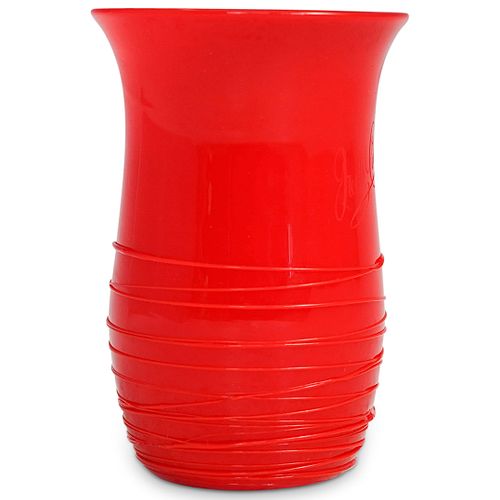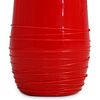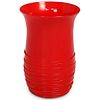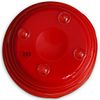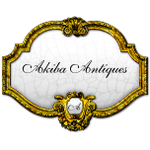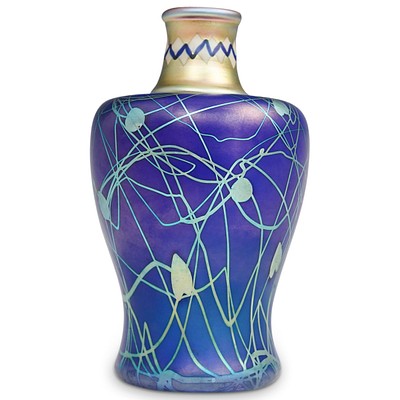Steuben Rouge Flambe Tumbler
Lot 22
About Seller
Akiba Antiques
3 N Federal Hwy
Dania Beach, FL 33004
United States
Akiba Antiques, founded by Charles and Franceska Akiba in the 1980’s in Paris, France started by buying and selling fine arts. Franceska specialized in French furniture from the fine Napoleonic Era to La Belle Epoque, to Art Nouveau and Art Deco; While Charles’ expertise lied in European paintings b...Read more
Categories
Estimate:
$200 - $2,000
Absentee vs Live bid
Two ways to bid:
- Leave a max absentee bid and the platform will bid on your behalf up to your maximum bid during the live auction.
- Bid live during the auction and your bids will be submitted real-time to the auctioneer.
Bid Increments
| Price | Bid Increment |
|---|---|
| $0 | $20 |
| $500 | $50 |
| $1,000 | $100 |
| $2,000 | $250 |
| $5,000 | $500 |
| $10,000 | $1,000 |
| $25,000 | $2,500 |
| $50,000 | $5,000 |
| $100,000 | $10,000 |
| $250,000 | $25,000 |
About Auction
By Akiba Antiques
Jul 29, 2021
Set Reminder
2021-07-29 12:00:00
2021-07-29 12:00:00
America/New_York
Bidsquare
Bidsquare : The Marvelous Collection of Mr & Mrs Shovers
https://www.bidsquare.com/auctions/akiba-antiques/the-marvelous-collection-of-mr-mrs-shovers-7184
The collection of Alan and Susan Shovers offers one of the rarest selections of Steuben glass available. Alan and Susan are both experts in the field - together, they authored the book "Objects of Desire: The Art of Frederick Carder" Akiba Antiques info@akibaantiques.com
The collection of Alan and Susan Shovers offers one of the rarest selections of Steuben glass available. Alan and Susan are both experts in the field - together, they authored the book "Objects of Desire: The Art of Frederick Carder" Akiba Antiques info@akibaantiques.com
- Lot Description
DESCRIPTION: Rouge flambe toothbrush holder with tomato red towards orange coloring and random reeding at the bottom.
Soda-lime glass.
Signed Fredk Carder at the side, above the reeding.
Reference:
Shape 6767, p. 245 Gardner.
Pictured at p. 99-100 of Objects of Desire, The Art of Frederick Carder by Alan Shovers
Eric E. Ericson in the first volume to his treatise, A Guide to Colored Steuben Glass 1903 - 1933 p. 9 says, Frederick Carders favorite and most difficult glass to make was the only production to carry his personal AFREDK CARDER in bold Spencerian script. Other special presentation pieces were often signed in the same manner, but these were not production Steuben in the sense we shall consider in this treatise.
See Advertising brochure where this piece is identified in the brochure as to shape Fig. 6.15 p. 140 of Frederick Carder and Steuben Glass by Thomas P. Dimitroff. At p. 239 Fig. 10.92, a paperweight cologne is shown with the Intarsia style signature on the base on the side.
Shape shown on the cover of Frederick Carder steuben Glass by Marshall Ketchum.
See shape p. 55 of A Guide to Colored Steuben Glass 1903 - 1933 by Eric E. Ericson.
Jim Barlow reports on 5/30/02 following a research trip to the Rakow that he found a reference to a rouge flambe with reeded know shape #6158(puff box/candy jar). Retail $6.00; in Cerise Ruby the most common color, $7.50.
Toothbrush holders were commonly sold in sets with a tumbler and a soap dish. There is a matching Rouge Flambe tumbler, shape 1185, with reeding. In Alan Shovers collection, piece.
This is the least likely glass to be encountered among any of the Carder opaques or semi opaques, or for that matter, among almost any type of his glass. A vivid dense warm red leaning toward the yellow or orange direction, it is made of a combination of chemicals, one of which was selenium that required careful proportioning and manipulation to produce the rich tomato-like color. Mr. Carder states that this was very difficult to make and that very few pieces were made. lll. No. H-23, see p. 112 Carder steuben Glass Handbook and Price Guide by John F. Hotchkiss.
Like Mandarin Yellow, Rouge Flambe was also inspired by Chinese porcelains; both these glasses were made in shapes suggestive of oriental ceramics, and both were difficult to produce and particularly vulnerable to breakage caused by strains within the glass.
Rouge Flambe pieces range in color from a rich red, as in Color Plate XXIII A, which was the color Carder was seeking, to an orange or coral tone. The color was produced by the addition of selenium and cadmium sulfide to the glass batch. As a result of the production difficulties, Rouge Flambe was made for only about two years, probably in 1916 and 1919. (See also Color Plate XXIV A.) The Glass of Frederick Carder by Paul V. Gardner, p. 81
Viewing Plate XXIII of Gardner the tallest piece is 6 2 A. Also, the decorated piece shown at plate XXIV is 4 1/4" H.
Rouge Flambe is among the rarest of Carder glasses. Fig. 8.58, p. 198 of Frederick Carder and Steuben Glass by Thomas P. Dimitroff. Technical production difficulties, such as glass formulas that yielded unstable glass, also could result in very few items be made. This was the case with Mandarin Yellow, Rouge Flambe, and Moresque. As a result, all of these types are rare and extremely valuable. p. 239
In Color, this ware resembles a delicate tomato-red. It was made of the metallic substance selenium and a precise amount of cadmium sulfide. The manufacture of this glass was quite precarious due to the delicacy involved in both the melting process and heat treatment. The finished product has a soft, warm appearance.
The marketing of this product was quite late in the 1920's and perhaps a year into the 1930's. It is an exceedingly scarce item, little being made or sold due to the tumultuous period of introduction. P. 67 of a Guide to Colored Steuben Glass 1903 -1933 (Book I), by Eric E. Ericson.
Another of the little-seen type of Steuben Glass but remembered once seen for its striking rich red tomato color in a dense opaque body which Mr. Carder reported as extremely difficult to make and likely to be unstable structurally. The few pieces that are seen are almost without exception in important collections and therefore, like similar rarities, values can be an approximation of what a seller and buyer might agree upon. The scale of value would place it above Intarsia and below Diatreta. As a more specific valuation, it may be placed somewhere between the low and mid five figure prices. Art Glass Prices #3 by John F. Hotchkis 1967).
Rouge Flambe glass is one of the most strikingly explosive shades achieved in glass. In view of the exact control needed for the mix, as well as the proper heat of the fire, very little variation may occur before a piece falls short of its natural brilliance. These pieces must be recognized, as they were rarely signed, but using Steuben shapes as reference along with the outstanding red color, it is highly unlikely that one will overlook such a piece. Art Glass Nouveau by Ray and Lee Grove, p. 156.
This rare art glass type, consisting of fewer than one hundred examples, was produced by Frederick Carder about 1916-1917. Its color, ranging from tomato red to orange, and even coral pink, has a bright surface texture and was not acidized or iridized. Proved to be fragile, causing straining and cracking of the glass the addition of minute, metallic flecks of chrome oxide gave the ware a pearly finish. P. 40 of The Collector's Encyclopedia on American Art Glass by John A. Shuman III.
See, similar wise, also at p. 146 of American Art Nouveau Glass by Albert Christian Revi.
Color shown in a plate in a 1926 AD in House and Garden labeled {Steuben Glass hand wrought in the old tradition and bearing the label Steuben Glass Blown and modeled (id) at Steuben Furnaces, Corning, N.Y. The inscription reads Rouge flamme (id), the color of the small plate, is one of the rarest and most striking colors ever developed in glass.
On the record interview between Carder and Philpot. The Fieldstone Porch Presents Conversations with Carder on Steuben his American Art Glass Carder says, contrary to several books that say the Intarsia signature is engraved, that he signed the Intarsia pieces, estimated at 35 in number. In the book, For Real bob Rockwell The an and His Collection by Mary Elizabeth Wahlig at p. 119 the author says: As far as Bob can recall, Aurene is the only type he would sign with its name with one exception; Bob recalls, Carder did sign just one piece Rouge flambe, fred Carder.
Opaque and lined with flint white per Beth Shaut of Rockwells. Beth Shaut originally opined that this wasn't an authentic piece of Rouge Flambe because she never saw rouge flambe with reeding. She also opined that Frederick Carder never signed pieces with that form of signature on the side of a piece, except for Intarsia pieces. Subsequently, on around Feb. 26, 2002 she reported talking to Bobby Rockwell who Said it was Steuben and that the color and translucency on the edge was from being over cooked. She then goes on to apologize because she was wrong. In Glass Art Reflect the Future: Art and technical glass from the collection of The Paul Vickers Gardner Glass Center, Published at Alfred University 2002 p.3 it states: Carder never produced this fragile glass commercially; 25 large pieces known to exist may be viewed in the Frederick Carder Collection of the Corning Museum of Glass. The experimental pieces in the exhibit demonstrate the variance between translucency and opacity, depending on the degree of crystallization that occurred.
Jim Barlow examined additional pictures of the signature and concluded it was engraved. He states the signature is one of two things. The work of a Master engraver who isn't bothered by forging something or it is by the person who put on all the signatures on the pieces of Intarsia at Steuben. He concludes the signature looks awfully authenticate. See signature at p. 234 of Dimitroff, Fig. 10.83, Frederick Carder and Steuben Glass and also p. 135 of The Glass of Frederick Carder by Paul V. Gardner. Also p. 200 of Thomas P. Dimitroff's book in fig. 8.65 a Rouge Flambe piece is signed with the AFredk Carder on the bottom post-production. Perfect match on an Intarsia piece shown at
http://www.glassclub.org/8_22x.htm
Provenance:
Estate of Mr. and Ms. Alan Shovers
Acquired 3/8/02 from Troy Jenkins of Sarasota, FL.
CIRCA: 1900s
DIMENSIONS: H: 4.5" x D: 3"
CONDITION: Great condition. Normal signs of age. See lot description for details on item condition. More detailed condition requests can be obtained via email (info@akibaantiques.com) or SMS 305-332-9274. Any condition statement given, as a courtesy to a client, is only an opinion and should not be treated as a statement of fact. Akiba Antiques shall have no responsibility for any error or omission. - Shipping Info
-
For shipping please contact our 3rd party shipper: UPS STORE 954 4541131 auctions1937@gmail.com Contact Name:David
-
- Payment & Auction Policies
-
Available payment options
Thank you and congratulations on your new purchase!
-
-
- Buyer's Premium



 EUR
EUR CAD
CAD AUD
AUD GBP
GBP MXN
MXN HKD
HKD CNY
CNY MYR
MYR SEK
SEK SGD
SGD CHF
CHF THB
THB